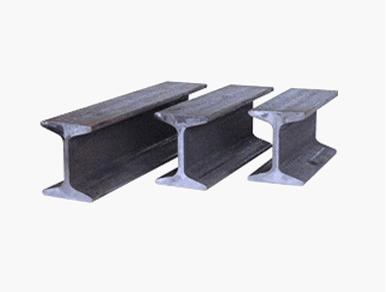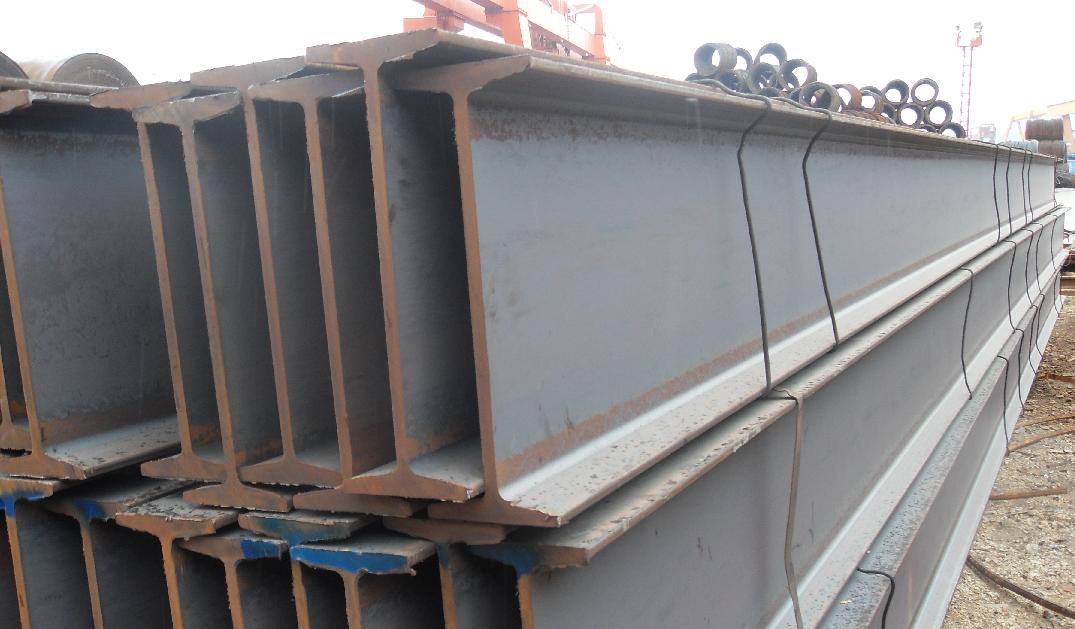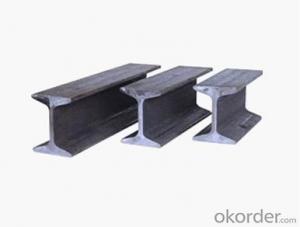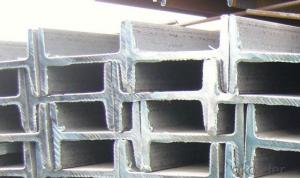Stainless Steel I Beam/I Beam Steel 2015 New Competitive
- Loading Port:
- Nanjing
- Payment Terms:
- TT OR LC
- Min Order Qty:
- 4000 PCS
- Supply Capability:
- 30000 PCS/month
OKorder Service Pledge
Quality Product, Order Online Tracking, Timely Delivery
OKorder Financial Service
Credit Rating, Credit Services, Credit Purchasing
You Might Also Like
2015 New Competitive Stainless Steel I Beam Details
| Leg Height: | 68-180mm | Depth: | 100-500mm | Standard: | BS,JIS,ASTM,DIN,EN,GB,AISI |
| Grade: | A36 - A572 | Place of Origin: | China (Mainland) | Brand Name: | Pangang |
| Model Number: | Q235 | Application: | Construction | Surface: | Smoonth |
Packaging & Delivery
| Packaging Detail: | According To Export's Demand Or Customer's Requires |
| Delivery Detail: | In 10 -20 days |
Product Basic Information:
| Material | Q195,Q235,Q345, Grade D,SS400,S235JR,1.0038,304,316,316L,201,202,410,420,ETC |
| Standards | GB/T 13793-1992 ,ASTM,JIS,EN 10025 ETC |
| Origin place | Made In China |
| Delivery Condition | Hot rolled |
| Surface require | Black,Hot Dipped Galvanization,Polish |
| Packing | 1.Seaworthy Packing 2.Wooden Case 3.Carton,Woven Bag Or At Client's Requires |
| Delivery time | In 10-30 days |
| Trade Term | EXW,FOB,CIF |
| Payments | T/T or L/C at sight |
| Port | China main Port,such as shanghai,Dalian,Shenzhen port. |
| MOQ | 1 Ton |
| Product Advantages | 1.Very Fast Delivery Time 2.High Quality And Reasonable Price 3.Sizes Are Enough 4.Many In stocks In warehouse 5.Provide The Sample For Free |
2015 New Competitive Stainless Steel I Beam Pictures


- Q:Can steel I-beams be used in healthcare facilities or hospitals?
- Indeed, healthcare facilities and hospitals can utilize steel I-beams. Construction frequently relies on steel I-beams because of their robustness, longevity, and capacity to bear substantial loads. In healthcare facilities, where both safety and structural stability are paramount, these beams are frequently employed to establish a sturdy foundation for the building. These beams are capable of supporting the weight of walls, floors, and ceilings, thereby guaranteeing the overall stability of the structure. Furthermore, steel I-beams possess fire and pest resistance, rendering them particularly suitable for healthcare facilities, where safety and hygiene are of utmost significance.
- Q:What are the considerations for wind load design for steel I-beams?
- When designing steel I-beams for wind load, several key considerations need to be taken into account. Firstly, the geographical location and local wind speeds are crucial in determining the magnitude of the wind load. Additionally, the exposure category of the site, which defines the terrain and surrounding structures, is important in assessing the wind pressure coefficients. The building height and shape also influence the wind load distribution on the I-beams. Lastly, the material properties, connection details, and the structural design codes and standards must be carefully considered to ensure the I-beams can withstand the anticipated wind forces without failure.
- Q:How do steel I-beams perform in terms of vibration control?
- The exceptional strength and load-bearing capabilities of steel I-beams are widely acknowledged. However, their ability to control vibrations may vary depending on various factors. To begin with, steel I-beams have a specific frequency at which they naturally vibrate. This frequency is determined by their dimensions, material properties, and overall structural configuration. If the vibration's frequency matches the beam's natural frequency, resonance can occur, resulting in heightened vibrations that could compromise the structure's integrity. To mitigate vibrations in steel I-beams, several strategies can be employed. One common approach involves increasing the beam's stiffness by adding extra steel plates or braces. This raises the beam's natural frequency, reducing its susceptibility to resonance with external vibrations. Furthermore, damping systems can be integrated into the design of steel I-beams to dissipate energy and minimize vibrations. These systems typically consist of damping materials like viscoelastic polymers or rubber pads, which absorb and dissipate vibrational energy. It is important to note that the vibration control performance of steel I-beams can also be influenced by the surrounding structural elements and the overall design of the building or structure. For example, the presence of other damping elements like tuned mass dampers or base isolators can further enhance the vibration control capabilities of steel I-beams. To summarize, steel I-beams possess natural frequencies that impact their vibration control performance. By increasing stiffness and incorporating damping systems, vibrations can be mitigated, ensuring the overall structural integrity. However, it is vital to consider specific design requirements and surrounding structural elements to optimize the vibration control performance of steel I-beams.
- Q:What are the different types of connections used for steel I-beams?
- There are several different types of connections used for steel I-beams, depending on the specific application and structural requirements. Some common types of connections include: 1. Welded Connections: This is the most common and widely used type of connection for steel I-beams. It involves welding the I-beam to a connection plate or another beam to create a strong and durable joint. 2. Bolted Connections: Bolted connections are another common method used to connect steel I-beams. This involves using bolts and nuts to fasten the beams together. Bolted connections can be easily adjusted or dismantled if needed, making them a flexible option. 3. Riveted Connections: Riveted connections were historically used but are less common nowadays. This method involves using rivets, which are metal pins with a formed head on one end, to connect the I-beams. Riveted connections provide high strength and durability. 4. Pinned Connections: Pinned connections allow for rotational movement between the connected beams. This type of connection is often used in structures where flexibility is required, such as bridges or seismic-resistant buildings. Pinned connections typically use pins or bearings to allow rotation. 5. Moment Connections: Moment connections are designed to transfer both vertical and horizontal loads between beams. These connections are used in structures where a rigid connection is required to resist bending moments. Moment connections can be achieved through welding or bolting, and they provide high strength and stability. It's important to note that the choice of connection type depends on factors such as load requirements, structural design, and construction methods. Consulting with a structural engineer or a qualified professional is crucial to ensure the appropriate connection type is chosen for specific applications.
- Q:I want to use a lever beam point, two meters away from the middle of the fulcrum, to lift two tons half the weight of I-beam with much?
- Generally, stainless steel needs the worst stress, slightly better carbon steel, and low-alloy steel is the best. But in low alloy steels, the steels with higher strength tend to have lower toughness and worse toughness. They require severe deflection and overall instability, but will reduce the load-carrying capacity of the steel, increase the size and waste the material.Generally on the market, the common Q235-B, Q345, more. The parameter you are giving is incomplete. I wonder if you could estimate the coefficient of the lifting dynamic load If the dynamic coefficient of the 1.65 of the general equipment lug is concerned, the overall instability will be a destructive factor. You're more reliable than 20A or 20b i-beam. I think it would be safer to smash 250B I-beam if I often throw it crosswise. But the weight of 2 and a half tons is very low. Not very tall. The steel structures I make often hoist more than 60 tons.
- Q:How do steel I-beams perform in terms of sound insulation?
- Steel I-beams do not perform well in terms of sound insulation. This is because steel is a dense and rigid material that easily transmits sound vibrations. As a result, steel I-beams can act as conduits for sound, allowing it to travel through the structure and making it difficult to achieve effective sound insulation. To improve sound insulation in buildings with steel I-beams, additional measures such as adding insulation materials, using acoustic panels, or implementing soundproofing techniques may be necessary.
- Q:Can steel I-beams be used for chemical processing plants?
- Yes, steel I-beams can be used for chemical processing plants. Steel is a commonly used material in these types of industrial applications due to its strength, durability, and resistance to corrosion. I-beams, specifically, are often used in structural framing to provide support and stability to the overall structure of the plant. Chemical processing plants typically involve the handling and processing of various chemicals and substances, some of which can be highly corrosive or hazardous. Steel, especially when coated or treated with corrosion-resistant materials such as galvanization or specialized coatings, can withstand the harsh conditions found in chemical processing environments. Additionally, steel I-beams offer several advantages for chemical processing plants. They have a high load-bearing capacity, allowing them to support heavy equipment, piping, and storage tanks. The flexibility and versatility of steel make it easier to construct complex designs and accommodate the changing needs of the plant. However, it is important to note that the specific requirements of each chemical processing plant may vary, and it is crucial to consider factors such as the type of chemicals being processed, temperature, pressure, and other environmental conditions. Consulting with structural engineers, architects, and relevant experts is recommended to ensure the appropriate selection, design, and installation of steel I-beams for a chemical processing plant.
- Q:What is the allowable stress for 40B I-beam?
- Ordinary I-beam, light I-beam flange is variable cross-section, by web plate thickness, external thin; H steel: HW, HM, HN, HEA, HEB, HEM and so onOrdinary I-beam, lightweight I-beam has formed the national standard, the common 10# I-beam is equivalent to the Internet I100 (such as 10# also channel equivalent channel (U100) for the implementation of the standards of different countries, which have subtle differences in their specifications)
- Q:How do steel I-beams perform in terms of fire protection?
- Steel I-beams generally have poor performance in terms of fire protection. While steel is a strong and durable material, it quickly loses its structural integrity when exposed to high temperatures. In a fire, steel I-beams can warp, buckle, and eventually collapse, posing a significant safety risk. To enhance fire protection, steel I-beams are often coated with fire-resistant materials or encased in fire-resistant barriers to delay heat transfer and maintain their load-bearing capacity for a longer duration.
- Q:Can steel I-beams be used for elevated storage racks or shelves?
- Yes, steel I-beams can be used for elevated storage racks or shelves. Steel I-beams are strong and durable, making them ideal for supporting heavy loads. They provide stability and structural integrity, making them suitable for storing heavy materials or equipment on elevated levels. Additionally, steel I-beams can be easily customized and designed to fit specific storage requirements, ensuring that the shelving system is efficient and safe. Overall, steel I-beams are a popular choice for elevated storage racks or shelves due to their strength, durability, and flexibility in design.
1. Manufacturer Overview |
|
|---|---|
| Location | |
| Year Established | |
| Annual Output Value | |
| Main Markets | |
| Company Certifications | |
2. Manufacturer Certificates |
|
|---|---|
| a) Certification Name | |
| Range | |
| Reference | |
| Validity Period | |
3. Manufacturer Capability |
|
|---|---|
| a)Trade Capacity | |
| Nearest Port | |
| Export Percentage | |
| No.of Employees in Trade Department | |
| Language Spoken: | |
| b)Factory Information | |
| Factory Size: | |
| No. of Production Lines | |
| Contract Manufacturing | |
| Product Price Range | |
Send your message to us
Stainless Steel I Beam/I Beam Steel 2015 New Competitive
- Loading Port:
- Nanjing
- Payment Terms:
- TT OR LC
- Min Order Qty:
- 4000 PCS
- Supply Capability:
- 30000 PCS/month
OKorder Service Pledge
Quality Product, Order Online Tracking, Timely Delivery
OKorder Financial Service
Credit Rating, Credit Services, Credit Purchasing
Similar products
New products
Hot products
Hot Searches
Related keywords




























